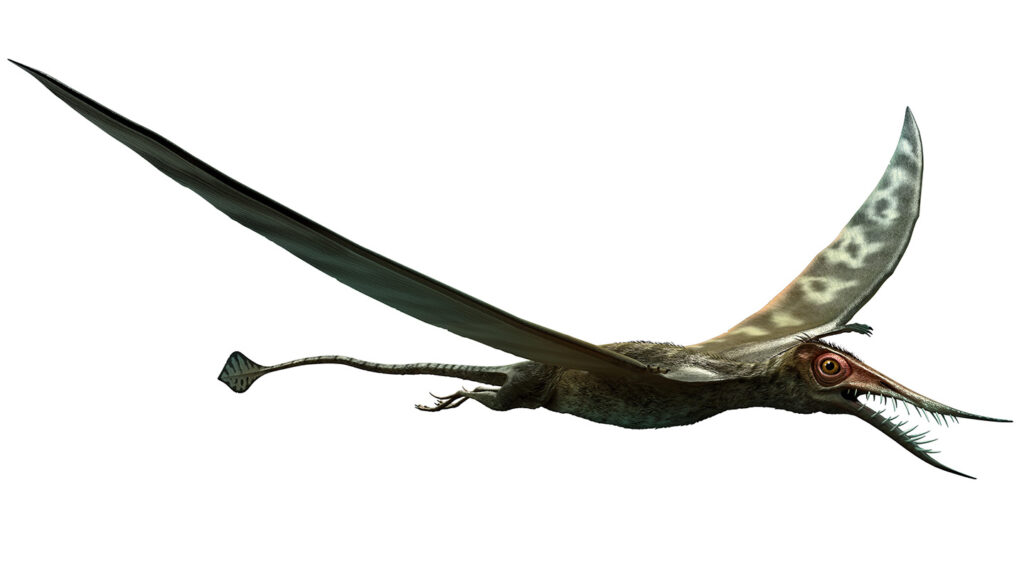One pterosaur species gave itself quite the makeover as it grew older and larger.
Scientists have spent more than a century wondering if a large and anatomically quirky flying reptile fossil represented a distinct species from its much smaller peers. Not so, researchers report January 2 in PeerJ. The Jurassic “giant,” they argue, is a superlative for this species. The findings help reveal how the extinct fliers may have warped physically and ecologically over their lives.
Rhamphorhynchus was a snaggle-toothed pterosaur that lived in parts of what is now Europe and Africa during the Jurassic Period roughly 150 million years ago. It’s one of the best-known pterosaurs, with well over 100 fossilized remains known to science.
But one nearly complete fossil skeleton unearthed in the mid-1800s from limestone deposits in southern Germany stood out from the rest. Most adult Rhamphorhynchus had a wingspan in the 1-meter range, comparable to that of a crow. But this special fossil was far larger, with an eaglelike wingspan. The fossil had initially been treated as a distinct species, but in 1995, one scientist proposed that all known Rhamphorhynchus instead belonged to a single species, R. muensteri. Yet the conspicuously king-sized example left lingering doubts, says David Hone, a paleontologist at Queen Mary University of London.
“This thing is big and weird,” he says. “Maybe this is a different species, and we’ve not really looked at it properly.”
Hone and independent paleontologist Skye McDavid conducted a deep dive on the mysterious skeleton, evaluating its eccentricities.
The researchers made detailed measurements of the skull and body of the fossil, comparing them to other Rhamphorhynchus specimens. The team did find plenty of unique characteristics. In life, the animal would have had a 1.8-meter wingspan, making it over 60 percent larger than all but one of the largest known Rhamphorhynchus. The eye sockets were also proportionally smaller, and the skull openings behind the eyes were bigger.
But the researchers argue that these and other features are in line with the stepwise shifts in proportions that pterosaurs and other animals go through as they get larger. The Jurassic jumbo appears to be what R. muensteri eventually grows into.
“It’s a very cool specimen,” says Natalia Jagielska, a paleontologist at the Lyme Regis Museum in Dorset, England. “I’m glad it finally has been described in detail, not just in passing.”
One of the most fascinating features of the fossil are its teeth. Other, smaller R. muensteri had interlocking, needlelike teeth with round cross sections, Hone says. The supersized specimen had curiously broad, flattened teeth. Hone thinks the compressed shape of the teeth, coupled with the animal’s overall large size, means it was eating something different than what its smaller cousins ate.
The wee versions of the pterosaurs ate tiny shrimp and fish says Hone. For the colossal adult, such snacks “just fall between its teeth.”
Its diet may have included more terrestrial prey, like lizards or small mammals. As a result, larger R. muensteri may have also spent less time near the ocean, heading inland along rivers and estuaries. This kind of separation into different ecological niches with age would have been largely unavoidable for animals like pterosaurs and dinosaurs, Hone says, since they started as very small hatchlings and are thought to have grown throughout their entire lives.
“Every single stage of life is a slightly different animal,” Jagielska says.
Dave Unwin, a paleontologist at the University of Leicester in England, isn’t on board with the idea that the older, larger individuals may have changed their dining habits or residence. The anatomy of the pterosaur is “wholly unsuited” for foraging in terrestrial environments, he says, and the skeletal and tooth differences in the big pterosaur are better explained as the consequence of having the predictably heavier build that comes with increasing size overall.
Either way, work like this can help researchers better understand how pterosaurs grew throughout their lives, says Rudah Duque, a paleontologist at the Federal University of Pernambuco in Recife, Brazil.
“For many years, many [pterosaur] species were described, sometimes without good criteria, as there were few materials for comparison, generating a plethora of taxa that often represent individuals of the same species, but of different ages or sexes,” Duque says. Recent finds across different life stages have boosted researchers’ understanding of pterosaur biology more generally, he says. “But we still have much to discover.”
Read the full article here


